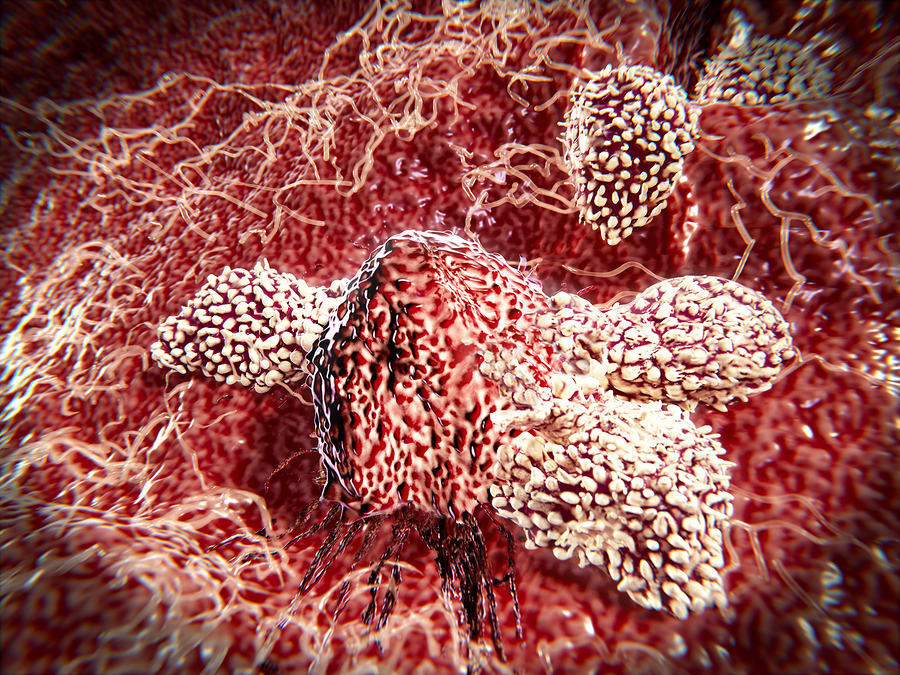When a tumor is first detectable, it can be benign. Benign means gentle, or in the case of cancer, not harmful. Most cancers begin this way: as clumps of rapidly dividing cells that do not otherwise interfere with any other processes of the body. The problem begins when the tumor becomes invasive and starts releasing non-adhesive cancer cells that eventually travel throughout the body.
The process of cancer becoming decentralized and spreading throughout the body is referred to as metastasis and marks a significant point at which cancer becomes much more harmful to the body. This article will review the process of metastasis and provide insight for natural ways to control it based on the specific components of this process highlighted in this review.
What Leads to Spreading of Cancer Cells?
Before cancer is able to spread, it must elicit changes in its surrounding environment that inhibits the body’s defenses against it. The two major changes that occur before metastasis can begin are secretion of connective tissue-dissolving enzymes and the formation of blood vessels on the tumor (angiogenesis). This combination of events breaks down the connective tissue surrounding the tumor while providing a physical route for cancer cells to spread.
Cells that belong to certain tissues are held in place by adhesive proteins called integrins. Not only do these proteins hold cells in place but they also regulate the permeability of a tissue by blocking bacteria, viruses, and even cancer cells from entering. Beyond their structural function, evidence suggests that these proteins play a major role in cell communication and can influence several key factors of cancer development.
Connective Tissue-Dissolving Enzymes
Cancer cells, as readily adaptive cells, have developed a chemical mechanism with which to disrupt the function of integrins. It has been found that cancer cells actually release a set of enzymes called metalloproteinases (MMP) that have the ability to dissolve connective proteins such as integrins and thereby degrade the surrounding tissue.
Specifically, MMP-2 and MMP-9 have been the primary focus of research in this process area of interest. Cancers with high levels of these enzymes have been shown to be much more malignant, meaning metastasis is likely to occur and at a much higher rate.
MMPs were first thought to be solely responsible for the degradation of the cells surrounding a tumor but further research uncovered that these enzymes actually influence several factors in cell communication pathways and even play a role in inflammation responses as well.
Reducing Connective Tissue BreakDown
Because these enzymes are a major contributing factor contributing to metastasis, it is important to implement strategies to better regulate MMP activity. Natural compounds that have shown beneficial in this regard are EGCG, curcumin, luteolin, and quercetin. Also, since cell communication and inflammation are keys to controlling cancer in general, implementing these strategies provides broad therapeutic benefit.
In addition to inhibiting the MMP enzymes mentioned, another more recent approach to prevent metastasis focuses on strengthening the tissues thereby increasing their resistance to being degraded. Nutrients that are important for promoting the integrity of tissues in the midst of high levels of MMP-2 and MMP-9 are Vitamin C, Zinc, Magnesium, flavonoids, and procyanidins.
Angiogenesis: Forming New Blood Vessels
Before cancer cells from a tumor can migrate into the bloodstream and spread throughout the body, they must first leave the confines of the tumor. While the MMP enzymes degrade the surrounding tissue and increase its permeability, the tumor begins to form unique blood vessels that serve two major functions.
First, they supply the tumor with blood and nutrients needed to continue growing. Secondly, they act as transportation for cancer cells to leave the tumor. The blood vessels surrounding a tumor are unique because they lack structural integrity to a degree that makes them extremely permeable. This makes it easy for cancer cells to leave the tumor.
Factors Involved with Angiogenesis
The structural integrity that is lacking in these new blood vessels may be due to the upregulation of MMP enzymes that are also responsible for degrading surrounding tissues. This makes the importance of implementing strategies to control MMP expression all the more compelling.
Important contributing factors toward angiogenesis include chronic inflammation, hypoxia (low oxygen), and oxidative stress. By controlling these factors (easily managed via accurately planned diet) angiogenesis can be prevented, controlled, or possibly reversed. Controlling these factors will, in addition, effectively lower the aggressiveness of the cancer.
Minimizing Inflammation
Systemic inflammation has a high direct correlation with the rate of metastasis. The biological markers, cyclooxygenase and lipoxygenase (COX and LOX), have been measured specifically to show this. COX and LOX are two enzymes in the body involved in an inflammatory chemical pathway called the eicosanoid pathway.
Studies have shown that lowering the levels of COX and LOX enzymes through anti-inflammatory protocols can have a significant positive impact in cancer conditions. The flavonoids apigenin and kaempferol each have the ability to inhibit both enzymes. Additionally, curcumin, berberine, and garcinol have all demonstrated the ability to inhibit several inflammatory pathways including the production of COX and LOX enzymes.
Activating the NRF2 Pathway
Because the malignancy of a cancerous growth is largely influenced by the inflammation and oxidation of its environment, one of the most powerful strategies to control metastasis may be upregulation of the NRF2 signaling pathway (7). Doing so not only increases antioxidant defenses and lowers inflammation, but also has the added benefit of improving systemic detoxification, resulting in lower amounts of free radicals due to toxin buildup.
Four natural compounds that have been researched and touted for their notable ability to support the NRF2 signaling pathway are EGCG, Curcumin, sulforphane, and resveratrol. That is why I have developed NRF2 power to provide all of these critical nutrients in clinical doses. This is something I recommend for any patient of mine seeking to support their body’s defenses against cancer.
Early Detection, Safely
Another thing to consider when on one’s journey to heal cancer is to detect it early. For this reason, many people subject themselves to diagnostic procedures on a yearly basis that expose their bodies to harmful radiation that can accumulate over time and actually end up promoting cancer growth.
RELATED ARTICLES:
- Hops Herb Fights Breast Cancer and Menopause Symptoms
- Epstein-Barr Virus Connection to Breast Cancer & Autoimmune Disorders
- New Studies Show Optimizing Vitamin D Levels May Double Chances of Surviving Breast Cancer, Lower LDL Cholesterol and Helps Prevent Autism
This is why I recommend, and use with my patients, an extremely safe, full-body, cancer detection procedure called thermography. This screening technique can assess the whole body at once for signs of inflammation and is a very effective method for detecting cancer. This method does not expose the body to any harmful radiation and can accurately detect cancer development years before traditional methods can. As a preventative measure, I recommend having this kind of procedure done yearly.
Final Thoughts
Similar to any chronic disease, cancer development is a product of the immediate environment of its origin. Many of the epigenetic (gene influencing) factors that lead to cancer growth and eventually metastasis, can be significantly controlled by the way one alters the internal environment of the body.
The safest and most effective way to do this is by supporting the body nutritionally. The strategies outlined in this article have been provided to educate and empower you on your healing journey and may be used to help effectively control cancer metastasis.
*Article originally appeared at Dr. Jockers.




















